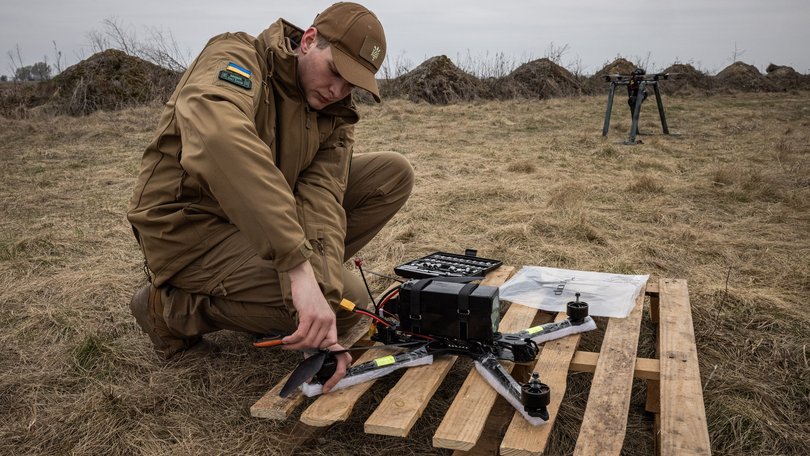Ukraine drone strike on Russian airfields showcases brazen, modern warfare innovation as conflict grinds on

For 18 months, Ukraine’s internal security service planned an audacious assault on far-flung Russian airfields - first sneaking drones into Russia, then planting them near key military runways.
On Sunday, just ahead of a new round of peace talks, it was go time: Near four unsuspecting Russian military bases, remotely activated roofs lifted off mobile homes and sheds parked on flatbed trucks. Armed Ukrainian drones tucked inside soared upward, then pounced on military aircraft lined up on the runways, engulfing many in flames.
The brazen attack - which Ukrainian officials claimed destroyed at least 13 Russian aircraft and damaged dozens of others - shocked Russia and instantly reduced its capabilities to threaten a nuclear attack or launch missile strikes on Ukraine and other countries. It also served as a crucial reminder to Moscow and Ukraine’s Western partners that Kyiv remains capable of exploiting Russia’s weaknesses and disrupting its war plans, despite being outnumbered and outgunned.
Sign up to The Nightly's newsletters.
Get the first look at the digital newspaper, curated daily stories and breaking headlines delivered to your inbox.
By continuing you agree to our Terms and Privacy Policy.Ukraine said the damaged or destroyed aircraft, some of which were nuclear-capable, included A-50, Tu-95, Tu-22 M3 and Tu-160 models - planes Kyiv said Russia had used nearly every night to bomb Ukraine.
Many details of how the attack was planned are not public, and it was not immediately clear how many of the Russian planes were operational at the time they were targeted.
But the swift, angry reactions in Russia confirmed that Ukraine had exploited - to devastating effect - an obvious vulnerability: essential and expensive aircraft left out in the open but believed safe because they were deep inside the country. The operation also marked the latest example of drone technology redefining modern warfare.
Western analysts said the strikes will hinder Russia’s ability to launch cruise missiles into Ukraine and could force Russian commanders to shift significant resources to better protect aviation assets. But the analysts cautioned that the strikes are unlikely to significantly alter the course of the war, as Moscow still has enough aircraft to continue bombing Ukrainian cities and infrastructure.
Video footage and reactions published on social media showed that in Russia, the drone strikes stirred panic, confusion and then, from pro-war commentators, rage. Governors from several regions, including as far as Siberia, reported drone attacks. Russian onlookers filmed smoke billowing over the airfields and narrated their shock. Soon, pro-war military bloggers had dubbed the attack “Russia’s Pearl Harbor.”
In videos that could not be independently verified by The Washington Post, people who appear to be locals living around the air bases recorded drones zooming past them and plumes of black smoke on the horizon. In one video, a woman watches a drone move toward a smouldering air base as her neighbours suggest that it might be the 11th to fly by. In another video, a man films as several drones fly out of the back of a truck stationed on the side of a highway. A volley of gunfire can be heard in the background as security forces try to shoot the drones down.

In another, a young soldier, apparently stationed at another air base, records several aircraft burning. Facing the camera, he uses an expletive to describe the scene. Enraged chief Russian propagandist Vladimir Solovyov later demanded that the soldier be shot for making the video and called him a “scumbag.”
Meanwhile, in Kyiv, the SBU, the Ukrainian security agency that had planned the brazen strikes, publicly took credit and revealed the operation’s code name as Spiderweb. President Volodymyr Zelensky quickly posted photos of himself hugging the agency head, Lt. Gen. Vasyl Maliuk, in celebration.
“The enemy thought that it could bomb Ukraine and kill Ukrainians with impunity and endlessly,” Maliuk said in a statement Monday. “But this is not so. We will respond to Russian terror and destroy the enemy everywhere.”
Ukraine said that all SBU operatives involved in the attack were evacuated safely from Russia before it began.
In Ukraine, the successful attack injected some much-needed optimism into a society beleaguered by more than three years of full-scale war and worn down by what many see as undue US pressure to concede to Russian demands even without security guarantees.
“This operation completely changes the perception of reality - both within Russia and around the world. Our enemies are now forced to recognise that Ukrainian intelligence services are capable of penetrating even the most secure facilities,” said Ukrainian lawmaker Roman Kostenko, who serves as the secretary of parliament’s national security committee. “When the enemy loses dozens of strategic bombers, it’s not just a technical loss; it’s a blow to its ability to blackmail the world with missile strikes.”
Former Ukrainian defence minister Oleksii Reznikov said Ukraine had transferred its Tu bombers to Moscow as part of its 1996 agreement to give up its nuclear capabilities in exchange for security guarantees from several countries, including Russia.
“On June 1, 2025, Ukraine began removing those very aircraft from one of the memorandum’s main guarantors. That guarantor had shamelessly used them against peaceful Ukrainians,” he said, describing Sunday’s attack as “a peculiar form of military-legal sanctions.”
One former Ukrainian official, who spoke on the condition of anonymity to discuss a sensitive political moment, described the attack as providing an “immense inspirational push for Ukrainian society and soldiers” that he fears may inspire more resistance to a compromise that could lead to a real ceasefire.
“We’re less likely to compromise in the nearest future. And some form of a compromise seems to be the only way to stop [or] pause the war,” he said. Still, he added, the attack dramatically improved the SBU’s reputation and “deserves to be described in history books.”
The vulnerability of aircraft has long been a point of criticism among Russian military bloggers, who have called for better defences, such as hardened cover and hangars, said Samuel Bendett, a drone expert and adviser to the Russia studies program at the Centre for Naval Analyses, a research and analysis nonprofit in Washington.
Air defences on the bases were probably honed to detect bigger Ukrainian drones that operate at long ranges and were “probably not looking for FPV drones that literally snuck under the radar,” Bendett said. FPV drones are small aircraft guided by a pilot using a camera with a first-person view. A big question is how Russia rebuilds the bruised component of its nuclear arsenal, Bendett said.
Among the destroyed or damaged planes are aircraft that have been modernised but are no longer in production. It would not make sense to rebuild propeller-driven Tu-95s, Bendett said, though Russia has yet to acquire the next-generation bombers expected to replace them.
Another question is how Ukraine ultimately steered the drones. The sophistication of launching the drones one after another points to capabilities such as drones preprogrammed to fly toward their targets, analysts said.
Pilots may have been involved in the last stretch of the attack runs, Bendett said. In one video, a drone slows down and hovers above the wings of a bomber, then targets a vulnerable portion of the wing between the fuselage and the engine, he said. Such a precise attack is a hallmark of FPV drones, which carry relatively small payloads but pack a big punch by specifically targeting vehicle weak points.
Russian officials and state media, meanwhile, remained noticeably silent on Sunday’s attacks.

According to Russian outlet Agentsvo, Russian state broadcasters Channel One and Rossiya-1 each devoted 40 seconds of airtime to this unprecedented attack on distant Russian air bases. By Monday morning, the news had disappeared from news bulletins.
“The smartest thing Putin could do right now would be to not respond immediately,” wrote Vladimir Pastukhov, a Russian political scientist based in London. “Putin’s best response is to delay his response - which he is good at.”
“Putin does not have many spectacular ‘good’ moves in the current situation,” he continued. “Ukraine has no comparable facilities that can be destroyed without infernal civilian casualties and enormous damage to the environment … which would traumatise the already troubled Trump.”
Pro-Kremlin military blogger Mikhail Zvinchuk, who runs the Rybar Telegram channel, said that the attack would cause substantial “moral and psychological damage” and that Ukraine’s operation was aimed not only at exploiting gaps in defence but also at “creating colossal tension” in society and discrediting the security services.
If Ukraine can attack air bases, he speculated, it could also attack highways and transport routes, stirring panic.
“Of course, from the point of view of undermining Russia’s military potential, this is an extremely unpleasant story, especially in the context of the loss of the Tu-95MS,” Zvinchuk said, referring to the mainstay of Russia’s fleet of nuclear bombers.
Russian opposition figures, meanwhile, marveled online at Ukraine’s “amazing” and “crazy” operation.
“Everyone says that the only way to negotiate with Putin is to negotiate from a position of strength. Well here it is,” wrote Russian opposition politician and former political prisoner Ilya Yashin on social media.
Yan Matveyev, a military analyst at the Anti-Corruption Foundation, founded by opposition figure Alexei Navalny, described the attack as “a direct and highly sensitive blow to the nuclear triad” that destroyed “rare and expensive bombers.”
“Most importantly, it reduced the Russian Air Force’s ability to strike Ukrainian cities,” Matveyev wrote on Telegram.
Destroying or damaging an A-50 is a significant achievement for Ukraine. The aircraft, topped with a radar, is a flying command centre that helps coordinate Russian air attacks and detects incoming threats. Moscow has few in its inventory. One such plane was shot down with a Ukrainian Patriot air defense system last year.
Ebel reported from London and Horton from Washington. Natalia Abbakumova in Riga, Latvia, contributed to this report.
© 2025 , The Washington Post
